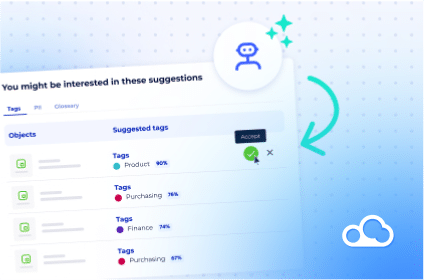In the expansive domain of data management, reference data management has emerged as a critical segment to ensure uniformity, accuracy, and consistency in enterprise data. Reference data management, or RDM, deals with the management of data that defines the set values or classification standards used across an organization.
As businesses increasingly rely on data-driven insights, understanding the nuances and significance of RDM becomes paramount. In this journey, tools like the data catalog and metadata management tool have become indispensable allies.
Reference data defined
Reference data is a fixed landmark in the constantly changing data world: These are sets of values or categorizations that remain relatively static over time and provide a consistent reference point in a dynamic environment. Essentially, it’s the data about data. When we talk about reference data, we refer to data sets that categorize, qualify, or enumerate other data.
For instance, in an international sales database, the country codes, such as “US” for the United States, “UK” for the United Kingdom, and “AU” for Australia would be considered reference data. These codes provide a consistent way to refer to countries, ensuring that data entries remain standardized regardless of who is inputting the data or from which point of origin.
In a vast organizational ecosystem where data is sourced from myriad departments, systems, and external partners, reference data acts as the unifying thread. It ensures that everyone, irrespective of their function or geography, adheres to a standardized nomenclature, minimizing discrepancies and paving the way for accurate data-driven decision-making.
The importance of reference data management
In the intricate tapestry of an enterprise’s data framework, reference data management is the stitching that holds everything together. With a consistent set of reference points, data can transform from a set of disparate, conflicting entries: By ensuring uniformity, reference data management establishes a harmonious symphony of data that resonates with clarity and purpose.
Consider an international corporation operating in several countries. Without effective reference data management, the company’s India branch might refer to a product with a different code than the branch in Brazil. Such inconsistencies can lead to stock discrepancies, shipping errors, and financial misreporting.
RDM steps in to ensure that every unit of the organization, irrespective of its location or function, speaks a unified data language, fostering seamless operations and strategic alignment. In essence, while data might be the voice of an enterprise, reference data management ensures it sings in tune.
Components of reference data management
A holistic approach to RDM is akin to the intricate workings of a well-oiled machine. Each component plays a crucial role in ensuring the system runs seamlessly. One foundational aspect of RDM is the establishment of data governance protocols. This ensures an established body or set of guidelines overseeing the creation, alteration, and implementation of reference data. Without such a governing framework, reference data can quickly devolve into a chaotic mix of inconsistent values and definitions.
Integral to this ecosystem is a data catalog: It centralizes this data, making it easily accessible and navigable for all relevant stakeholders. Without a centralized data catalog, locating and utilizing reference data can be cumbersome, leading to inefficiencies and potential errors.
Complementing these components are tools and solutions designed to validate and cleanse data. As reference data acts as a benchmark for other data entities, ensuring its purity and accuracy is of paramount importance. Data validation tools scrutinize entries to ensure they adhere to predefined standards while cleansing solutions rectify or eliminate anomalies.
Together, these components form the robust backbone of a successful RDM framework, ensuring data remains a consistent, reliable asset for the enterprise.
Data catalogs as central RDM repositories
A data catalog in the realm of reference data management is not just a repository; it’s the lifeline that fuels a data-driven organization. In essence, it serves as the knowledge base where all reference data resides, meticulously organized, tagged, and described for easy accessibility. With the volume and complexity of data that modern businesses grapple with, a data catalog becomes indispensable, ensuring that stakeholders can swiftly locate and understand the reference data they require.
But beyond its role as a central storage hub, the data catalog also plays a pivotal role in ensuring data democratization. In today’s collaborative work environments, cross-functional teams often need access to specific reference datasets to drive their initiatives. The data catalog, with its structured and user-friendly interface, empowers them to access this data without the need for constant IT intervention.
Furthermore, as businesses grow and evolve, so does their reference data. New categories, values, or standards might emerge, while older ones could become obsolete. The data catalog acts as the dynamic platform that captures these evolutions, ensuring that reference data is not only accessible but also up-to-date and relevant.
The role of metadata management tools
In the realm of RDM, metadata management tools play a pivotal role – They not only catalog reference data but also provide insights into its lineage, usage, and relationships with other data entities. Such tools help organizations understand the broader context of their reference data, making its management more effective and insightful.
Challenges in reference data management
Managing reference data isn’t without its challenges. As businesses evolve, reference data sets can expand or change, requiring regular updates and validation. Ensuring that these changes are consistently reflected across all data platforms and systems can be a herculean task, especially in large, diverse enterprises.
The future of reference data management
As technology continues its march forward, the landscape of reference data management is set to undergo transformative changes. The integration of advanced AI algorithms with RDM tools can lead to more automated, intelligent systems that can predict, validate, and manage reference data with minimal human intervention.
Conclusion
By ensuring a consistent, accurate standard of data values, reference data management provides the foundation upon which meaningful data-driven insights can be built. Whether it’s through the use of a comprehensive data catalog or an advanced metadata management tool, the importance of RDM in today’s data-centric world cannot be overstated.
Learn even more about using your data as an asset to achieve higher levels of data governance and data quality. Book a demo today to get started on your organization’s journey to complete data l





